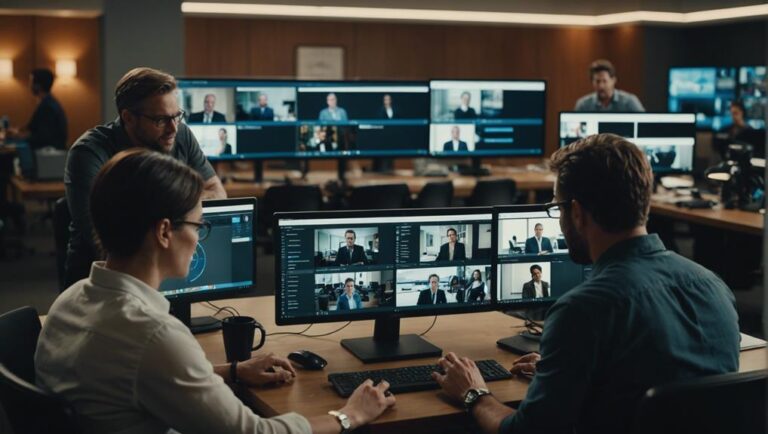Effective Communication Strategies for Remote Teams
To enhance remote team communication, prioritize clarity in instructions and practice active listening for understanding. Set guidelines for interactions, including boundaries and tone expectations. Utilize technology tools like virtual meeting platforms, instant messaging apps, and project management tools. Schedule regular check-ins at tailored frequencies and encourage transparent feedback. Build trust through open sharing and rapport. Manage conflicts promptly and promote active listening. Celebrate team achievements for morale. Effective strategies lay the groundwork for successful remote collaboration, addressing key aspects essential for team cohesion and productivity.
Importance of Clear Communication
Clear communication is essential for remote teams to effectively collaborate and achieve their goals. Providing clear instructions is important to make sure that everyone understands their tasks and responsibilities.
Active listening plays a key role in remote communication, as team members must attentively engage with one another to grasp information accurately.
Transparent feedback is another significant aspect of clear communication within remote teams. By providing honest and constructive feedback, team members can address any issues promptly and work towards improvement. This fosters trust among team members and promotes a culture of continuous learning and growth.
Building trust within a remote team is heavily reliant on clear communication. When team members communicate openly and honestly, they establish a foundation of trust that's essential for effective collaboration.
Establishing Communication Guidelines
Effective communication within remote teams begins by establishing clear guidelines to govern interactions and facilitate seamless collaboration. When establishing communication guidelines, it's important to set clear expectations for how team members should interact and communicate with one another. This includes defining boundaries for communication channels, response times, and the tone of messages exchanged. By outlining these expectations from the beginning, remote teams can avoid misunderstandings and make sure that everyone is on the same page.
Establishing boundaries is another key aspect of communication guidelines for remote teams. This involves determining when team members are expected to be available for communication, whether it's through instant messaging, email, or video calls. Clear boundaries help prevent communication overload and ensure that team members have dedicated time for focused work without constant interruptions.
Utilizing Technology Tools
You can enhance remote team communication by utilizing various technology tools.
Virtual meeting platforms facilitate face-to-face interactions.
Instant messaging applications enable quick exchanges.
Project management tools help coordinate tasks efficiently.
Leveraging these tools can streamline communication and foster collaboration among team members.
Virtual Meeting Platforms
Utilizing advanced technology tools, remote teams can enhance their collaboration by leveraging virtual meeting platforms for seamless communication and interaction. Virtual collaboration has become increasingly essential for remote teams to stay connected and work efficiently. Online meetings offer a way for team members to engage in real-time discussions, share ideas, and make decisions regardless of their physical location.
Virtual meeting platforms such as Zoom, Microsoft Teams, and Google Meet provide features like video conferencing, screen sharing, and chat options that facilitate effective communication among remote team members.
These platforms not only enable face-to-face interactions but also offer tools for collaboration, such as virtual whiteboards and file sharing capabilities.
Instant Messaging Applications
Instant messaging applications streamline real-time communication for remote teams, enhancing connectivity and efficiency in their collaboration efforts. When utilizing these tools, it's crucial to adhere to chat etiquette guidelines to maintain professionalism and clarity in conversations. Encourage team members to be brief yet detailed in their messages to guarantee effective communication.
Furthermore, instant messaging applications facilitate group collaboration by allowing multiple team members to engage in discussions, share ideas, and provide feedback simultaneously. Establish communication boundaries to prevent distractions and ensure that work-related discussions stay focused and productive.
One of the key advantages of instant messaging is the ability to receive real-time updates, making it easier for team members to stay informed about project developments and changes. Utilize features like read receipts and status updates to signify availability and responsiveness within the team.
Project Management Tools
Project management tools play an essential role in coordinating tasks and monitoring progress within remote teams, optimizing workflow efficiency and enhancing overall project outcomes.
Task tracking features in these tools allow team members to assign, prioritize, and track the status of tasks in real-time, ensuring everyone stays on the same page regarding project milestones and deadlines.
Collaboration platforms integrated into project management tools facilitate seamless communication among team members, enabling discussions, file sharing, and updates to be centralized in one location.
By utilizing these tools, remote teams can streamline project workflows, improve transparency, and boost productivity.
Additionally, project management tools offer features such as Gantt charts, Kanban boards, and progress reports, providing a visual representation of project timelines and progress.
With the aid of these technological solutions, remote teams can effectively coordinate their efforts, stay organized, and achieve successful project outcomes.
Scheduling Regular Check-Ins
To guarantee effective communication within your remote team, establishing a suitable check-in frequency is vital. By determining how often team members should touch base, you can maintain a sense of connection and productivity.
Utilizing various communication tools can streamline these regular check-ins, fostering collaboration and keeping everyone on the same page.
Check-In Frequency
Regular check-ins are vital for maintaining effective communication within remote teams. For weekly updates, consider scheduling a team meeting at the beginning of each week. This allows team members to align on goals, discuss priorities, and address any concerns before diving into individual tasks.
Daily standups, on the other hand, promote quick exchanges of information, updates on progress, and identification of any roadblocks that need immediate attention. These brief meetings enhance team collaboration and keep everyone informed on daily activities.
The frequency of check-ins should be tailored to the team's needs and the nature of the projects being worked on. While some teams may benefit from daily standups to ensure real-time updates, others might find weekly updates more suitable for their workflow.
It's important to strike a balance between staying informed and avoiding excessive meetings that could hinder productivity. By gauging the team's communication requirements and adjusting the frequency of check-ins accordingly, remote teams can foster stronger collaboration and achieve better outcomes.
Communication Tools
Consider utilizing digital calendar tools or scheduling apps to streamline and organize regular check-ins for your remote team. By leveraging these tools, you can establish a structured routine for communication, guaranteeing that all team members are aligned and informed. Setting up recurring meetings through platforms like Google Calendar, Microsoft Outlook, or scheduling apps such as Doodle or Calendly can help in avoiding conflicts and ensuring participation from all team members.
When scheduling regular check-ins, it's essential to establish communication etiquette guidelines. Clearly define the purpose of each meeting, share agendas in advance, and promote active participation from all team members. Additionally, ensure that everyone has access to the collaboration platforms being used for these check-ins.
Platforms like Slack, Microsoft Teams, or Zoom can facilitate seamless communication and enhance collaboration among remote team members.
Encouraging Transparent Feedback
Encourage team members to openly share feedback to foster a culture of transparency and continuous improvement within remote teams. Establishing a feedback culture where constructive criticism is valued creates an environment for open dialogue and growth.
Transparent communication is crucial for remote teams to address challenges effectively and enhance collaboration.
To promote transparent feedback, emphasize the importance of providing constructive criticism in a respectful manner. Team members should feel comfortable sharing their thoughts and ideas openly without fear of judgment. This promotes a culture where feedback is seen as a tool for improvement rather than as criticism.
Create channels for feedback that are easily accessible to all team members. Utilize communication tools that allow for anonymous feedback if individuals are hesitant to share openly. Regularly solicit feedback from team members to make sure that everyone has a voice in the process.
Setting Clear Expectations
To guarantee smooth workflow and effective collaboration within remote teams, clearly outlining expectations is essential for optimizing productivity and minimizing misunderstandings.
Setting boundaries is vital in remote work to establish guidelines for team members. Clearly defining work hours, response times, and task deadlines helps create a structured environment where everyone understands what's expected of them.
Team accountability plays a significant role in setting clear expectations. Each team member should be aware of their responsibilities and the impact of their work on the overall team goals.
Regular check-ins and progress updates can help reinforce accountability and make sure that everyone is aligned with the team's objectives.
Building Trust and Rapport
To build trust and rapport in your remote team, focus on transparency by sharing information openly and honestly.
Encourage team members to connect with each other beyond work-related tasks, fostering a sense of camaraderie and trust.
Emphasize the importance of open communication channels to make sure that everyone feels heard and valued in the team.
Trust Through Transparency
Establishing trust within a remote team can be achieved through transparency in communication, fostering a sense of openness and honesty among team members. By promoting honesty and building relationships based on trust, team members can feel more connected and confident in each other's intentions and actions.
Transparency involves sharing information openly, providing updates on progress, and being upfront about challenges or concerns. This level of openness helps prevent misunderstandings and cultivates a culture of trust within the team.
When team members are transparent in their communication, they create a supportive environment where everyone feels comfortable sharing their thoughts and ideas without fear of judgment. This leads to better collaboration, increased productivity, and stronger bonds among team members.
Transparency also helps in resolving conflicts more effectively, as team members can address issues openly and work towards solutions together.
Foster Team Connections
Promoting team connections through trust and rapport is fundamental in fostering a cohesive and collaborative remote work environment. In virtual team building, creating opportunities for team members to engage in activities that go beyond work-related tasks can enhance relationships and strengthen bonds.
Remote socialization plays a key role in fostering a sense of belonging and camaraderie among team members who may never meet face-to-face. Encouraging informal interactions through virtual coffee breaks, team building games, or online social events can help team members get to know each other on a personal level, leading to stronger connections and increased collaboration.
Building trust within a remote team requires intentional effort. Transparency, active listening, and consistent communication are essential components in fostering trust and rapport among team members. By creating a supportive and inclusive environment where team members feel comfortable sharing ideas and concerns, trust can flourish, leading to improved teamwork and productivity.
Encourage Open Communication
Encouraging open communication is pivotal in establishing trust and rapport within a remote team, fostering collaboration and productivity. Team bonding is greatly enhanced when team members feel comfortable expressing their thoughts, ideas, and concerns openly. By creating a communication culture that values transparency and active participation, remote teams can build stronger connections and work more effectively towards common goals.
When team members are encouraged to communicate openly, it promotes a sense of belonging and mutual respect. This, in turn, boosts morale and creates a supportive environment where everyone feels heard and valued. Additionally, fostering open communication helps prevent misunderstandings and conflicts by allowing team members to address issues proactively and constructively.
To cultivate a culture of open communication within your remote team, consider implementing regular check-ins, virtual team-building activities, and utilizing various communication tools to facilitate easy and efficient information exchange.
Encouraging team members to share their thoughts, ask questions, and provide feedback openly can lead to improved collaboration, increased productivity, and a more cohesive remote team dynamic.
Managing Conflicts Effectively
Effective conflict management is essential for maintaining productivity and cohesion within remote teams. Conflict resolution within a remote team requires a deep understanding of team dynamics.
When conflicts arise, address them promptly to prevent escalation. Encourage team members to express their concerns openly and respectfully. Acknowledge different perspectives and work towards finding a compromise that satisfies all parties involved. Utilize virtual platforms for conflict resolution meetings, allowing everyone to participate regardless of their physical location.
To manage conflicts effectively, establish clear communication channels and protocols within the team. Define how conflicts should be reported and resolved to guarantee a consistent approach. Consider appointing a neutral mediator to facilitate discussions and guide the team towards a resolution.
Emphasize the importance of active listening during conflict resolution to ensure that all viewpoints are considered. By addressing conflicts promptly and constructively, remote teams can maintain a harmonious working environment conducive to productivity and collaboration.
Promoting Active Listening
Implementing active listening techniques enhances communication effectiveness within remote teams. Active listening involves fully concentrating, understanding, responding, and remembering what's being said.
In remote collaboration, where face-to-face interactions are limited, active listening becomes even more essential for building strong relationships and fostering trust among team members.
To promote active listening within your remote team, start by encouraging team members to give their full attention during virtual meetings. This means minimizing distractions, such as multitasking or checking messages, to show respect for the speaker.
Additionally, practicing empathy and trying to understand the speaker's perspective before responding can help improve communication flow and prevent misunderstandings.
Another effective way to promote active listening is to summarize and repeat key points discussed during meetings. This technique not only demonstrates engagement but also ensures that all team members are on the same page.
Celebrating Team Achievements
Recognizing and acknowledging team accomplishments is essential for boosting morale and fostering a sense of camaraderie among remote team members. In the virtual setting, celebrating team achievements becomes even more significant for maintaining motivation and building a strong team dynamic.
Virtual celebrations can take various forms, such as team recognition emails, virtual parties, or shoutouts during online meetings.
Team recognition plays a pivotal role in remote team bonding, as it helps team members feel valued and appreciated for their contributions, despite the physical distance. By actively acknowledging and celebrating team achievements, you can strengthen a positive team culture and encourage continued collaboration and productivity.
Virtual parties or informal gatherings can also provide opportunities for team members to socialize and strengthen their connections outside of work tasks.
Conclusion
To sum up, effective communication is essential for remote teams to succeed. By establishing clear guidelines, utilizing technology tools, and fostering trust and rapport, teams can overcome the challenges of distance and achieve their goals.
For example, a marketing team increased productivity by implementing daily check-ins via video calls, resulting in improved collaboration and faster decision-making.
Remember, strong communication is the key to remote team success.







